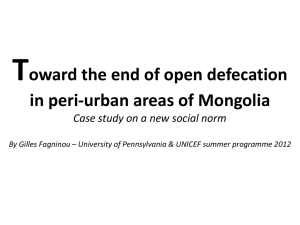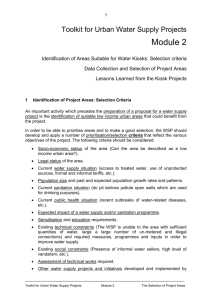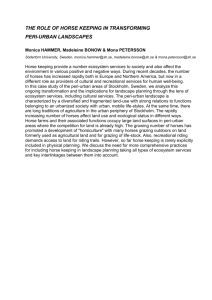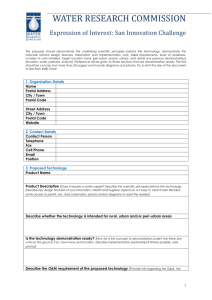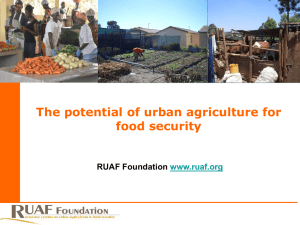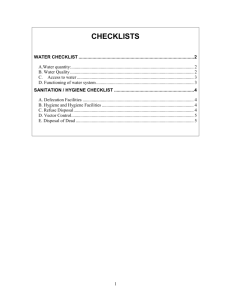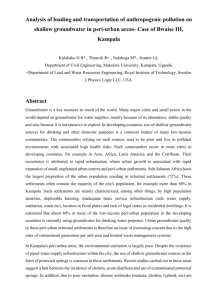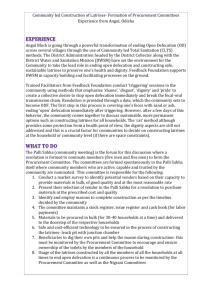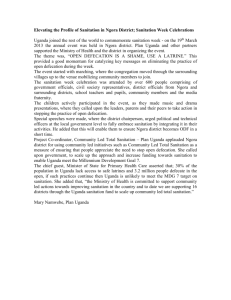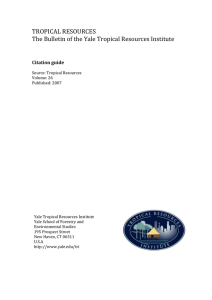Company Position, Person Profile
advertisement
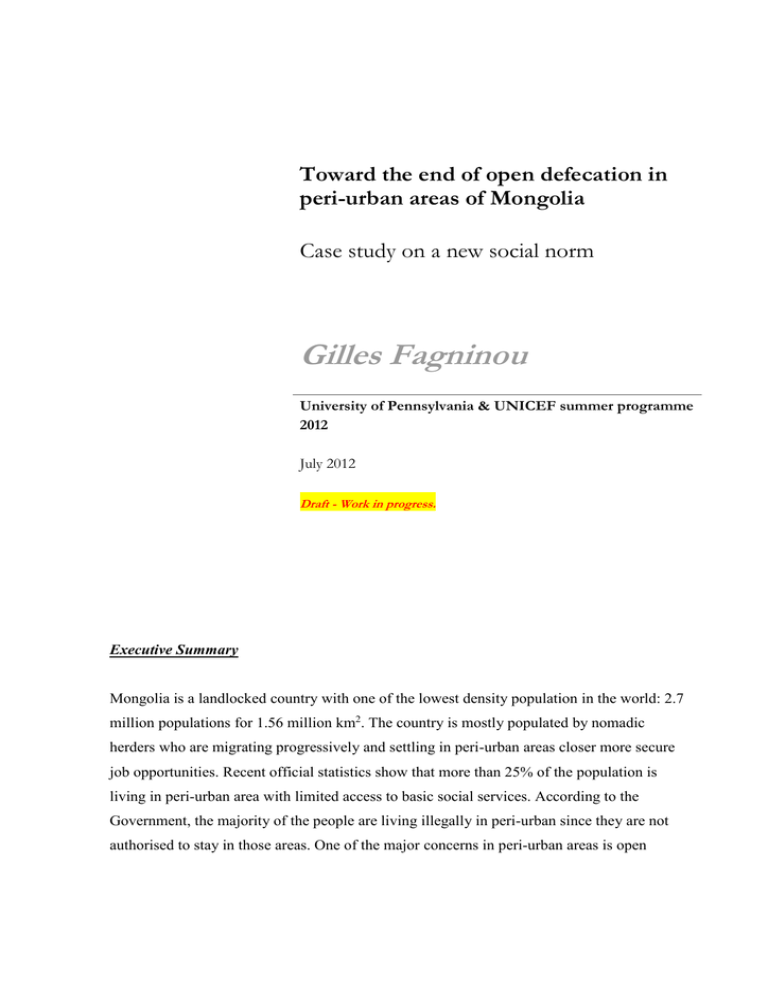
Toward the end of open defecation in peri-urban areas of Mongolia Case study on a new social norm Gilles Fagninou University of Pennsylvania & UNICEF summer programme 2012 July 2012 Draft - Work in progress. Executive Summary Mongolia is a landlocked country with one of the lowest density population in the world: 2.7 million populations for 1.56 million km2. The country is mostly populated by nomadic herders who are migrating progressively and settling in peri-urban areas closer more secure job opportunities. Recent official statistics show that more than 25% of the population is living in peri-urban area with limited access to basic social services. According to the Government, the majority of the people are living illegally in peri-urban since they are not authorised to stay in those areas. One of the major concerns in peri-urban areas is open defecation. Nomads move in peri-urban areas with the strong custom that they don’t need to use latrines and toilets. While in rural areas where the population is highly scattered, the impact of open defecation on mortality is not evident, it is proved that when the population is congested and households are physically settled close to each other, open defecation has a direct negative impact on mortality, especially on child mortality. This paper is proposing the creation of a social norm to end open defecation in peri-urban areas where a good household should have and use latrine. As social expectation matter a household in the community should expect other households to have and use latrines. Therefore, progressively, household will build and use latrine because they are convinced that other will do the same. This will be auto-regulated by community members since people knows that when someone open defecate it impacts not only on his health, but also on others health. That way, they will be in the community a strong alliance against the custom and a kind of interdependence in the community. An incentive will be created to reward the community with the highest latrine rate. Mongolian context Mongolia’s economy growth was about 17.6 % in 2011 and is expecting to increase during the coming years, mainly due to the mining sector growth. It faces high inflation, and soaring food prices. However, a significant percentage of the population remains largely untouched by the nation’s economic growth. The poverty rate has remained stagnant at 35% nationally and 50% in rural and peri-urban areas. 73% of the poor work in low-paying jobs in urban centres or in rural herding and farming households. Nationwide, 42% of children live in poverty and 21% suffer from chronic malnutrition. Mongolia also faces challenges related to its geography, harsh climate and lack of national road infrastructure, which make logistical planning and implementation costlier and more problematic than in many countries. Climate change has also engendered such challenges as increasingly extreme temperatures in summer and winter, water shortages, poor water quality, land degradation and desertification, all of which directly threaten livelihoods and national food security. According to the last national report on the MDGs published in May 2012, Mongolia is on track to meet 66 percent of its MDG targets. However, slow progress and some regressions have been the trend with the remainder, including those MDGs targeting water, sanitation, hygiene and the environment. More than 50% per cent of the rural population has no access to safe water and nearly 70% has no access to adequate sanitation. Lack of proper water and sanitation in rural schools and dormitories, where children spend up to nine months of the year, remains a critical area of concern. Limited water access and improper WASH facilities are common problems in schools and kindergartens. Only 25% of district schools have improved sanitation and 28% have access to adequate water. A recent study on school dormitory conditions showed that the water supply for 74% of 502 dormitories then in use, was carried from outside water kiosks and wells, and 46% of the water supply did not meet hygienic standards. Only 22% of the dormitories had indoor toilets and the remaining 78 % had outdoor latrines – most of which were unsafe and unhygienic. The Need for Latrines and Toilets Proper sanitation facilities (for example, toilets and latrines) promote health because they allow people to dispose of their waste appropriately. Throughout the developing world, many people do not have access to suitable sanitation facilities, resulting in improper waste disposal. Absence of basic sanitation facilities can: - Result in an unhealthy environment contaminated by human waste. Without proper sanitation facilities, waste from infected individuals can contaminate a community's land and water, increasing the risk of infection for other individuals. Proper waste disposal can slow the infection cycle of many disease-causing agents - Contribute to the spread of many diseases/conditions that can cause widespread illness and death. Without proper sanitation facilities, people often have no choice but to live in and drink water from an environment contaminated with waste from infected individuals, thereby putting themselves at risk for future infection. Inadequate waste disposal drives the infection cycle of many agents that can be spread through contaminated soil, food, water, and insects such as flies. Nomadic culture Mongolia is populated by nomads. Since nomads move from place to place according to the weather and where they can find grass for their herds, they don’t care about latrines and practice open defecation. The country land mass is huge, compare to the size of population; 1.56 million km2 for 2.7 million people according to the last Census 2012. With this low density (1.6 person per km2), and in the context of nomadic culture, herders are not leaving in community and very often a household is settled far from each other, there is no proof that open defecation has a noticeable impact on child mortality. In contrary, when population is in community, congested and physically close to each other, it’s scientifically confirmed that open defecation has a direct negative impact on child mortality. Progressively, with the change from socialism to open market economy, climate change and other transformations, the proportion of nomadic or semi-nomadic people in Mongolia has decreased over the time, from 60% in 1985 to 30% in 2010. This situation generates an important migration from rural to peri-urban areas. In 2010, according to the Worldbank around 25% of Mongolia population is living in peri-urban areas with only less than one out of three of them using latrines. This situation in a congested area is a threat for public health and is one of the causes of high mortality in peri-urban settings. Migrants in peri-urban area are coming from all over the country with different background and culture with one thing in common: the nomadic culture and customs. Even though they are stable and Figure 1: Dwelling of peri-urban area in Ulaanbaatar – Photo Gilles Fagninou choose not to move anymore, busy with small informal jobs, they still keep some of their behaviors and practice such as the low use of latrines. Open defecation: a strong custom According to Cristina Bicchieri1, a custom is “a pattern of behavior such that individuals prefer to conform to it because it meets their needs”. Open defecation in peri-urban areas is in line with that definition. That consistency of pattern is caused by the similar motivations and conditions of nomads settled in peri-urban areas. Each acts individually, and the result is an emergent pattern of action that reproduces itself. The preferences are unconditional: “Whatever other people do, I will open defecate”. The empirical expectations (expecting others to do) do not motivate them to act: “Yes, I know lots of people open defecate, so what?” Even when nomads move definitely to city centers, in peri urban area, they still believe that they don’t need latrine. People think that no one expects them to use a latrine and the belief is so strong that household shouldn’t have latrines is like a standard. Past and current interventions In the past, a range of supply driven interventions has been implemented to address the issue of open defecation in peri-urban areas. The approach used wasn’t successful and the custom resists strongly. The interventions were not able to influence and convince the population to change their practice. Another approach based on WASH in school was implemented during the last five years. The idea was to build latrines in schools and make sure that children are using the facility, assuming that they will influence their parents to build and use latrines. Even the family empowerment strategy used in UNICEF supported project succeeded in pushing the population to prioritize latrine, but in practice, few toilets were built and the use still low. 1 Professor at University of Pennsylvania - Sascha Jane Patterson Harvie Professor of Social Thought and Comparative Ethics and Director of Philosophy, Politics, and Economics Program (http://www.sas.upenn.edu/ppe/index.html) Create a social norm Given the strong nomadic custom and the fact that the community is built spontaneously by migrants with different background from all over the country, there is a need to have a norm that governs the community. An honor code - a good household should have and use latrine can push community members to change their custom. A household in the community should expect other households to have and use latrines, social expectation matter. Therefore, progressively, household will build and use latrine because they are convinced that other will do the same. An auto regulation mechanism by community members will naturally monitor the respect of the collective behavior. People knows that when someone open defecate it impacts not only on his health, but also on others’ health. That way, they will be in the community a strong alliance against the open defecation with a naturel auto-control mechanism that will create an interdependence among community members. Reference Group, public declaration and incentive Reference Group: the approach will be piloted in one peri-urban district (Nalaikh that has 22 communities) and will be expanded – at later stage - to other districts. The reference group is constituted by households living in peri-urban areas – a discussion with the community should lead to the identification of a core group with the 1st level of change agents and a monitoring mechanism. New migrants will find a strong social norm in place and progressively conform to it. Public declaration: after a consultative process takes place, the community will define when a public declaration will be made to reinforce the norm. Creation of network and incentive: in a participative manner, Nalaikh’s communities will form a network to share experiences; lessons learnt and challenge each other. An incentive will be created to reward the community that has the highest latrine rate per household or using any other performance criteria that the community may find appropriate. The reward should target the community to strengthen the interdependence and co-responsibility among members of community.
